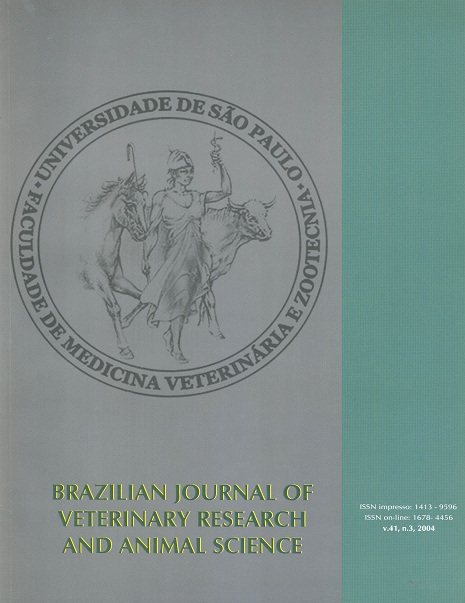Evaluation of two differents sutures for inciosional laparoscopic colopexy in dogs: a experimental study
DOI:
https://doi.org/10.1590/S1413-95962004000300002Keywords:
Laparoscopic surgery, Videolaparoscopy, Colopexy, DogsAbstract
Aiming to describe the laparoscopic technique for dog colopexy and to compare two suture materials 10 mongrel dogs separated in two groups of five (GV e GP). In the GV group the colopexy was realized with a polyglactin 910 3-0, and in the GP group a polypropylene 3-0 was used. For both procedures the dogs were positioned in dorsal recumbence and submitted to a pneumoperitoneum with CO2 using pressure of 12mmHg. Four trocars (two of 5mm and two of 10mm) were introduced in the left and right position of umbilical region. The descendent colon was grasped with a Babcock forceps and submitted to a seromuscular incision of 2.5 cm in the antimesenteric surface. A similar lesion was preceded in the transverse abdominal muscle, parallel with the ventral midline. The incisioned margins of colon and transverse abdominal muscle were sutured in two lines of simple continuous pattern. Fourteen days after the surgeries the dogs were submitted to laparoscopy surgery for evaluations of the peritoneal cavity and of the adherences occurred and to biopsies collections. The colopexy permanence was found in all dogs and the omentum fixation in the suture region was observed in 60% of GV dogs and 100% of GP dogs. Both suture materials were reported adequate for the colopexy procedure, however the polyglactin 910 suture was more easily realized due to its lower memory. In the histological analysis were observed that the connective tissue deposition was similar in both groups and in all 10 dogs the collagen fibers presented mature aspect. Based on the results presented herein, the proposed laparoscopic technique in adequate for colopexy procedure in dogs.Downloads
Download data is not yet available.
Downloads
Published
2004-06-01
Issue
Section
UNDEFINIED
License
The journal content is authorized under the Creative Commons BY-NC-SA license (summary of the license: https://
How to Cite
1.
Brun MV, Pippi NL, Beck CA de C, Contesini EA, Pereira RA, Stedile R, et al. Evaluation of two differents sutures for inciosional laparoscopic colopexy in dogs: a experimental study. Braz. J. Vet. Res. Anim. Sci. [Internet]. 2004 Jun. 1 [cited 2024 Apr. 16];41(3):154-61. Available from: https://www.revistas.usp.br/bjvras/article/view/6271





